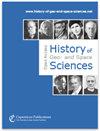Time and tide: pendulum clocks and gravity tides
IF 0.4
4区 哲学
Q4 GEOSCIENCES, MULTIDISCIPLINARY
引用次数: 1
Abstract
Abstract. Tidal fluctuations in gravity will affect the period of a pendulum and hence the timekeeping of any such clock that uses one. Since pendulum clocks were, until the 1940s, the best timekeepers available, there has been interest in seeing if tidal effects could be observed in the best performing examples of these clocks. The first such observation was in 1929, before gravity tides were measured with spring gravimeters; at the time of the second (1940–1943), such gravimeters were still being developed. Subsequent observations, having been made after pendulum clocks had ceased to be the best available timekeepers and after reliable gravimeter measurements of tides, have been more of an indication of clock quality than a contribution to our knowledge of tides. This paper describes the different measurements and revisits them in terms of our current knowledge of Earth tides. Doing so shows that clock-based systems, though noisier than spring gravimeters, were an early form of an absolute gravimeter that could indeed observe Earth tides.时间和潮汐:钟摆和重力潮汐
摘要重力的潮汐波动会影响钟摆的周期,从而影响任何使用钟摆的时钟的计时。由于直到20世纪40年代,钟摆一直是可用的最好的计时器,人们一直有兴趣看看这些时钟中性能最好的例子是否能观察到潮汐效应。第一次这样的观测是在1929年,在用春季重力仪测量重力潮汐之前;在第二次(1940年至1943年),这种重力仪仍在开发中。在钟摆不再是最好的计时器之后,在重力仪对潮汐进行可靠测量之后,进行了后续的观测,这更多地表明了时钟的质量,而不是对我们潮汐知识的贡献。本文描述了不同的测量方法,并根据我们目前对地球潮汐的了解重新审视了它们。这样做表明,基于时钟的系统虽然比春季重力仪噪音更大,但却是可以观测地球潮汐的绝对重力仪的早期形式。
本文章由计算机程序翻译,如有差异,请以英文原文为准。
求助全文
约1分钟内获得全文
求助全文
来源期刊

History of Geo- and Space Sciences
GEOSCIENCES, MULTIDISCIPLINARY-HISTORY & PHILOSOPHY OF SCIENCE
CiteScore
1.50
自引率
33.30%
发文量
10
审稿时长
50 weeks
期刊介绍:
The scope of History of Geo- and Space Sciences (HGSS) is to document historical facts and knowledge and to improve awareness of the history of geoscience. The knowledge of the development of geosciences and their experimental methods and theories in the past can improve our current understanding and may stimulate current research. It is encouraging for young scientists to read biographical material of historical figures in their research area. It is important as well to learn that history of science is an integrated part of the ongoing research in their research area. Another important aim of the journal is the association of historical retrospective and current research.
 求助内容:
求助内容: 应助结果提醒方式:
应助结果提醒方式:


